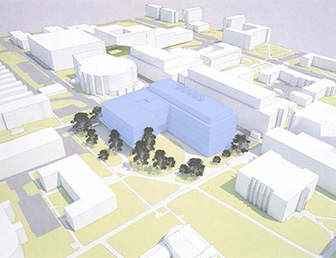Enhancing Education, Collaboration, and Research: Biomedical and Chemical Engineering to Open a New Facility in 2019

Concept only design, Copyright © 2015 HOK
The biomedical and chemical engineering departments will open the doors of a new facility in 2019, where the two departments will co-locate on the current site of Fenske Laboratory.
Estimated at $150 million, the project is currently the largest in Penn State’s capital budget. The new facility will provide 188,000 square feet of total space and will further enhance the College’s continued commitment to collaborative research across multiple disciplines by fostering a sense of community through shared workspaces and facilities.
Although the chemical engineering and biomedical engineering disciplines have different historical origins, the two now share important educational and research interests. Both departments have strong intellectual ties to the life and materials sciences. Co-locating these two departments near the core of the life/materials science concentration at University Park (close to the Life Sciences Building, the Chemistry Building, and the Millennium Science Complex, where the Huck Institutes of the Life Science and the Materials Research Institute are located) will enhance the impact of these two departments on university-wide interdisciplinary research and education.
The new building project will require a complete demolition of Fenske Laboratory, which has been the home of the Department of Chemical Engineering since its construction in 1960. The east wing was added in 1968 and only minor rehabilitation efforts have occurred in the last 47 years. Biomedical engineering is currently housed in the 18,000-square-foot Hallowell Building on University Park’s west campus. The building originally served as a swing space for mechanical engineering when Reber Building was renovated in 1987. It was later repurposed and renovated for the use of the biomedical engineering department as the program saw quick expansion in the 1990s.
Construction of the facility is expected to break ground in January 2017. The architect for the project, HOK, was announced at the Board of Trustees meeting on March 20, 2015.
Additional details regarding the building project are available on the Biomedical Engineering building project page.

